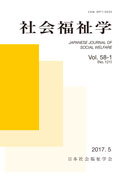Volume 58, Issue 1
Displaying 1-19 of 19 articles from this issue
- |<
- <
- 1
- >
- >|
Original Articles
-
2017Volume 58Issue 1 Pages 1-12
Published: May 31, 2017
Released on J-STAGE: September 22, 2017
Download PDF (471K) -
2017Volume 58Issue 1 Pages 13-25
Published: May 31, 2017
Released on J-STAGE: September 22, 2017
Download PDF (440K) -
2017Volume 58Issue 1 Pages 26-40
Published: May 31, 2017
Released on J-STAGE: September 22, 2017
Download PDF (835K) -
2017Volume 58Issue 1 Pages 41-56
Published: May 31, 2017
Released on J-STAGE: September 22, 2017
Download PDF (547K) -
2017Volume 58Issue 1 Pages 57-70
Published: May 31, 2017
Released on J-STAGE: September 22, 2017
Download PDF (459K) -
2017Volume 58Issue 1 Pages 71-85
Published: May 31, 2017
Released on J-STAGE: September 22, 2017
Download PDF (522K) -
2017Volume 58Issue 1 Pages 86-98
Published: May 31, 2017
Released on J-STAGE: September 22, 2017
Download PDF (572K) -
2017Volume 58Issue 1 Pages 99-111
Published: May 31, 2017
Released on J-STAGE: September 22, 2017
Download PDF (601K) -
2017Volume 58Issue 1 Pages 112-127
Published: May 31, 2017
Released on J-STAGE: September 22, 2017
Download PDF (569K)
Research Reports
-
2017Volume 58Issue 1 Pages 128-141
Published: May 31, 2017
Released on J-STAGE: September 22, 2017
Download PDF (380K) -
2017Volume 58Issue 1 Pages 142-152
Published: May 31, 2017
Released on J-STAGE: September 22, 2017
Download PDF (402K) -
2017Volume 58Issue 1 Pages 153-163
Published: May 31, 2017
Released on J-STAGE: September 22, 2017
Download PDF (449K)
Book Review
-
2017Volume 58Issue 1 Pages 164-166
Published: May 31, 2017
Released on J-STAGE: September 22, 2017
Download PDF (200K) -
2017Volume 58Issue 1 Pages 167-169
Published: May 31, 2017
Released on J-STAGE: September 22, 2017
Download PDF (194K) -
2017Volume 58Issue 1 Pages 170-172
Published: May 31, 2017
Released on J-STAGE: September 22, 2017
Download PDF (208K) -
2017Volume 58Issue 1 Pages 173-175
Published: May 31, 2017
Released on J-STAGE: September 22, 2017
Download PDF (178K)
Book Introduction
-
2017Volume 58Issue 1 Pages 176
Published: May 31, 2017
Released on J-STAGE: September 22, 2017
Download PDF (125K) -
2017Volume 58Issue 1 Pages 177
Published: May 31, 2017
Released on J-STAGE: September 22, 2017
Download PDF (135K) -
2017Volume 58Issue 1 Pages 178
Published: May 31, 2017
Released on J-STAGE: September 22, 2017
Download PDF (123K)
- |<
- <
- 1
- >
- >|
